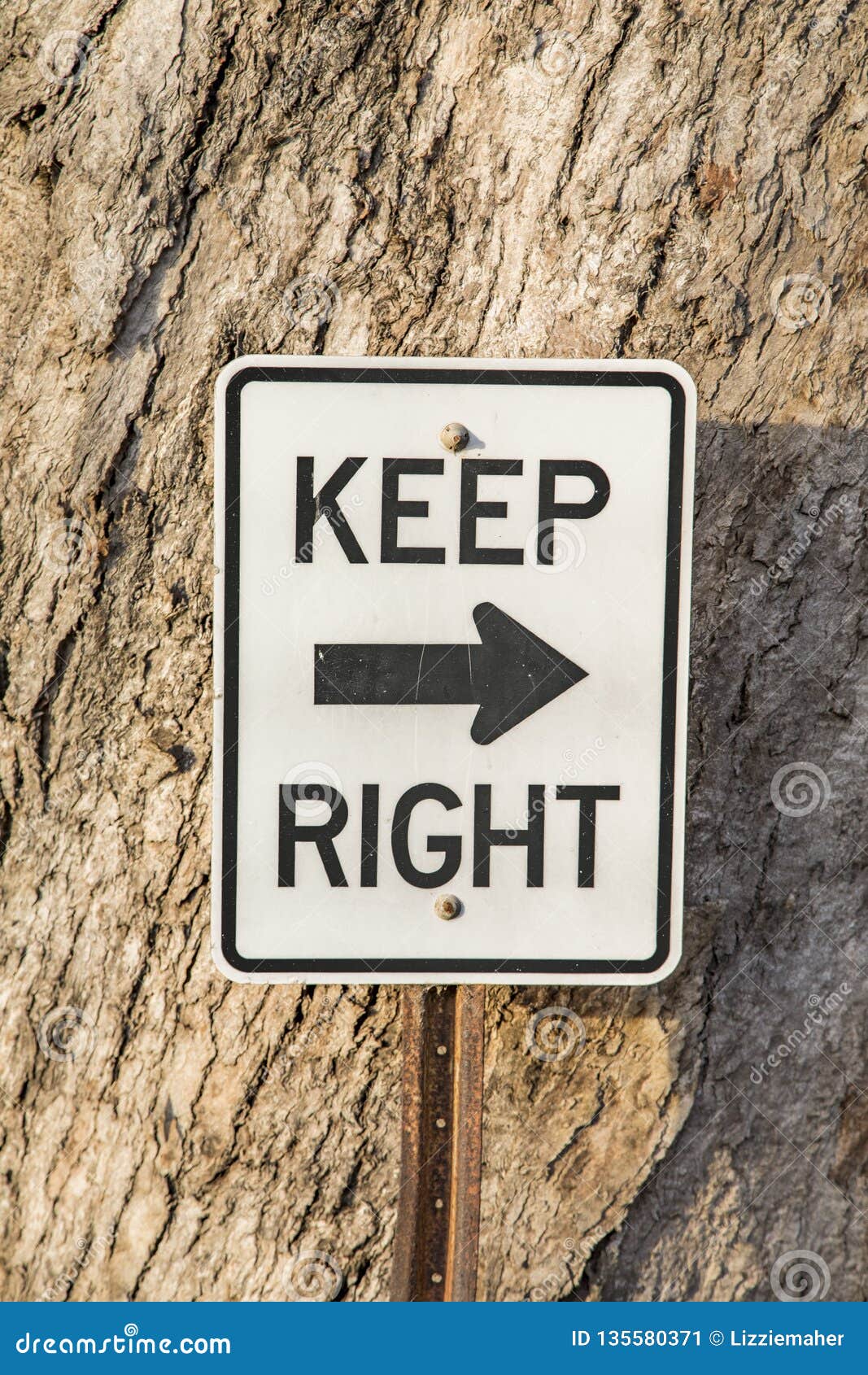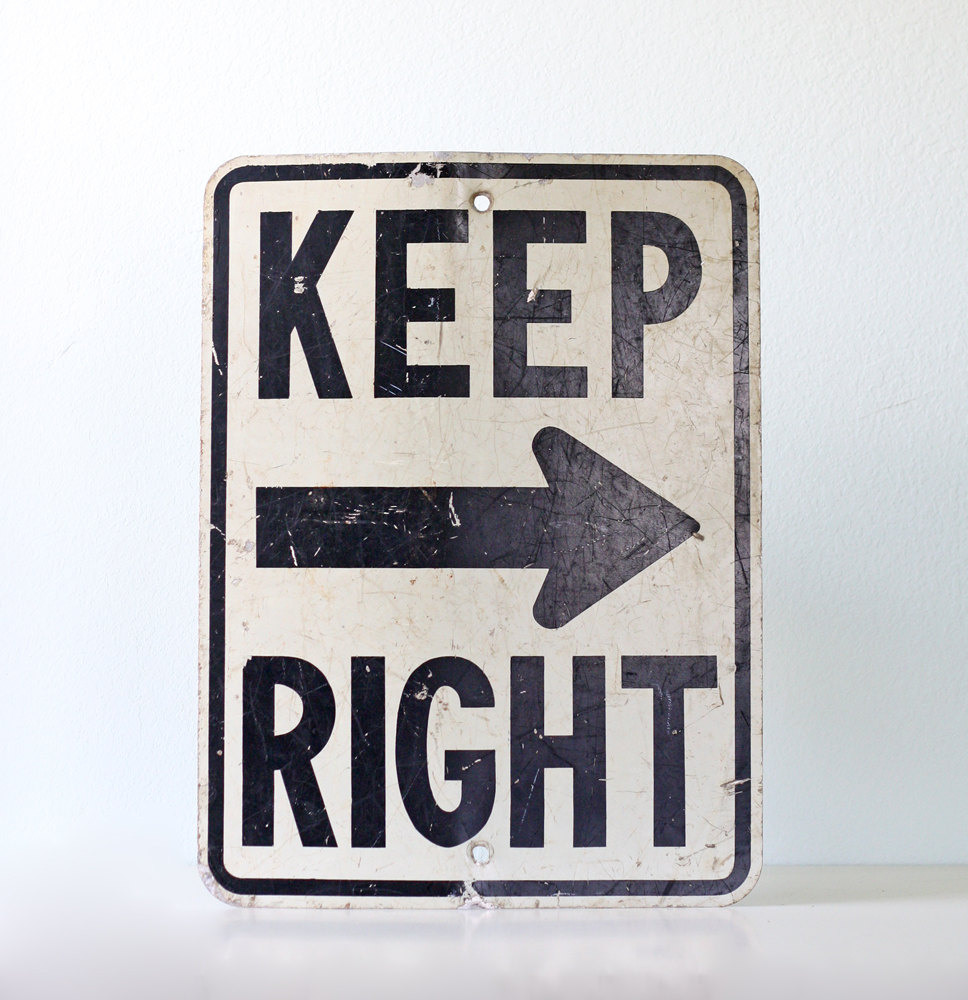
Warns you in advance that a bikeway crosses the roadway ahead. Do not enter if your vehicle is taller than the height listed on the sign. You will then be on a roadway with two-way traffic. The divided highway on which you are traveling ends 350 to 500 feet ahead. The highway ahead is divided into two one-way roadways. These signs give you advance notice of possible hazards ahead. School CrossingĪs you approach this sign, slow down, watch for children crossing the road. This five-sided sign means you are near a school. See pages 58-60 for typical warning signs. Words or symbols on the sign will show why you need to use caution. These signs warn you of special conditions or dangers ahead. This sign is placed on the left side of the road, facing the driver. Yield signs are usually placed where auxiliary roads lead into major roads. If the way is clear, you may move forward slowly without stopping. Slow down and give vehicles crossing your path the right-of-way.
#Keep right sign driver
If two vehicles reach the intersection at the same time, the driver on the left yields to the driver on the right. The first vehicle to reach the intersection should move forward first. Traffic from all four directions must stop. If there is no crosswalk, stop at a point nearest the intersecting roadway where you have a clear view of approaching traffic on the intersecting roadway before entering the intersection.Ī four-way stop sign means that there are four stop signs at this intersection. If there is no marked stop line, stop before entering the crosswalk on the near side of the intersection. A stop sign means that you must bring your vehicle to a complete halt at the marked stop line. Stop signs are always octagonal (8 sided). PENTAGON: School advance and school crossing signs.ĬROSSBUCK: Railroad crossing. VERTICAL RECTANGLE: Generally for regulatory signs. PENNANT: Advance warning of no passing zones.ĭIAMOND: Exclusively to warn of existing or possible hazards on roadways or adjacent areas. HORIZONTAL RECTANGLE: Generally for guide signs. The shape of a road sign can tell you as much about the sign's message as its color. BROWN: Public recreation areas and scenic guidance.Also used to identify parking spaces for disabled drivers. Each shape and each color has an exact meaning, so you must acquaint yourself with all of them. There are eight shapes and eight colors of traffic signs. Traffic signs - Standard Shapes and Colors You may drive in lanes beneath the green arrow, but you must also obey all other signs and signals. A yellow X means that your lane signal is going to change to red. You must never drive in a lane under a red X. To show which lanes are opened or closed.To show that a toll booth is open or closed.When the direction of the flow of traffic changes during the day.It is used at or just before dangerous intersections, or to alert you to a warning sign such as a school crossing or sharp curve. It is used at dangerous intersections.Ī flashing yellow light means you may move forward with caution. If the red light is burning at the same time, you must be in the proper lane for such a turn, and you must yield the right-of-way to vehicles and pedestrians within the intersection.Ī flashing red light means the same thing as a stop sign.

The yellow arrow means the same as the yellow light, but applies only to movement in the direction of the arrow.Ī green arrow, pointing right or left, means you may make a turn in the direction of the arrow. Left turns on red arrow from a one-way street into a one-way street are also allowed. Some intersections display a "NO TURN ON RED" sign, which you must obey.

After stopping, you may turn right on red arrow at most intersections if the way is clear. If turning left, wait for gap in oncoming traffic to complete turn.Ĭome to a complete stop at the marked stop line or before moving into the crosswalk or intersection. Yield to pedestrians and vehicles still in the intersection. Go - but only if the intersection is clear. Left turns on red from a one-way street into a one-way street are also allowed. Some intersections display a " NO TURN ON RED" sign, which you must obey. After stopping, you may turn right on red at most intersections if the way is clear. If traffic signals are out of order, stop as you would for a four-way stop sign.Ĭome to a complete stop at the marked stop line or before moving into the crosswalk or intersection. Some signals change only when a car is at the stop line. Stop on the stop line if your car is nearest the signal. Drivers, pedestrians, and bicycle riders must obey these signals except when an officer is directing traffic. Traffic signals are placed at intersections to keep traffic moving and avoid accidents.

Chapter 4 Chapter 4: Signals, Signs and Pavement Markings Traffic Control Signals


 0 kommentar(er)
0 kommentar(er)
